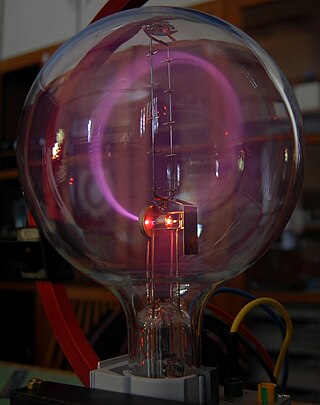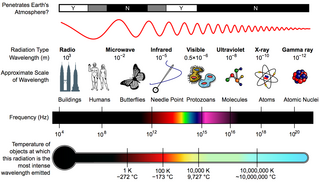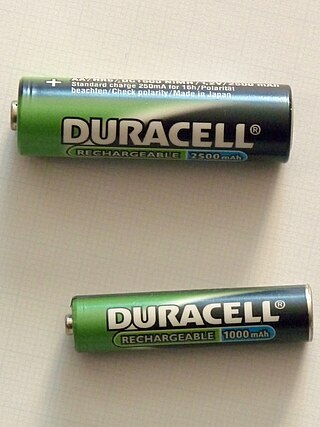
Cathode rays or electron beams (e-beam) are streams of electrons observed in discharge tubes. If an evacuated glass tube is equipped with two electrodes and a voltage is applied, glass behind the positive electrode is observed to glow, due to electrons emitted from the cathode. They were first observed in 1859 by German physicist Julius Plücker and Johann Wilhelm Hittorf, and were named in 1876 by Eugen Goldstein Kathodenstrahlen, or cathode rays. In 1897, British physicist J. J. Thomson showed that cathode rays were composed of a previously unknown negatively charged particle, which was later named the electron. Cathode-ray tubes (CRTs) use a focused beam of electrons deflected by electric or magnetic fields to render an image on a screen.

In physics, electromagnetic radiation (EMR) consists of waves of the electromagnetic (EM) field, which propagate through space and carry momentum and electromagnetic radiant energy. Types of EMR include radio waves, microwaves, infrared, (visible) light, ultraviolet, X-rays, and gamma rays, all of which are part of the electromagnetic spectrum.

The electromagnetic spectrum is the spectrum of electromagnetic radiation, ranging over a domain of frequencies and their respective wavelengths and photon energies.

Nikola Tesla was a Serbian-American inventor, electrical engineer, mechanical engineer, and futurist. He is best-known for his contributions to the design of the modern alternating current (AC) electricity supply system.

The positron or antielectron is the particle with an electric charge of +1e, a spin of 1/2, and the same mass as an electron. It is the antiparticle of the electron. When a positron collides with an electron, annihilation occurs. If this collision occurs at low energies, it results in the production of two or more photons.

X-ray is a high-energy electromagnetic radiation. In many languages, it is referred to as Röntgen radiation, after the German scientist Wilhelm Conrad Röntgen, who discovered it in 1895 and named it X-radiation to signify an unknown type of radiation.

Sir Joseph John Thomson was a British physicist and Nobel Laureate in Physics, credited with the discovery of the electron, the first subatomic particle to be found.

The antiproton,
p
, is the antiparticle of the proton. Antiprotons are stable, but they are typically short-lived, since any collision with a proton will cause both particles to be annihilated in a burst of energy.

The electric rays are a group of rays, flattened cartilaginous fish with enlarged pectoral fins, composing the order Torpediniformes. They are known for being capable of producing an electric discharge, ranging from 8 to 220 volts, depending on species, used to stun prey and for defense. There are 69 species in four families.
In physics, a charge carrier is a particle or quasiparticle that is free to move, carrying an electric charge, especially the particles that carry electric charges in electrical conductors. Examples are electrons, ions and holes. The term is used most commonly in solid state physics. In a conducting medium, an electric field can exert force on these free particles, causing a net motion of the particles through the medium; this is what constitutes an electric current. The electron and the proton are the elementary charge carriers, each carrying one elementary charge (e), of the same magnitude and opposite sign.

An ampere-hour or amp-hour is a unit of electric charge, having dimensions of electric current multiplied by time, equal to the charge transferred by a steady current of one ampere flowing for one hour, or 3,600 coulombs.
The Colombian electric ray is a species of fish in the family Narcinidae endemic to Colombia. Its natural habitat is open seas.
The brownband numbfish is a species of fish in the family Narcinidae found in eastern Colombia, Venezuela and Trinidad and Tobago. Its natural habitat is open seas.

The ocellated electric ray or bullseye electric ray is a species of electric ray in the family Narcinidae, native to the shallow inshore waters of the eastern central Pacific from the Gulf of California to Ecuador. Reaching 25 cm (9.8 in) in length, this species has a rounded pectoral fin disc and pelvic fins with convex margins. Its short and thick tail bears two dorsal fins and terminates in a triangular caudal fin. The ocellated electric ray is named for the distinctive large eyespot on the middle of its disc, consisting of a black or yellow center surrounded by concentric rings. Its dorsal coloration is otherwise highly variable, ranging from plain to ornately patterned on a light to dark brown background. The front part of its disc is darker brown.

The painted electric ray or variegated electric ray is a poorly known species of numbfish, family Narcinidae, native to the western Atlantic Ocean from southeastern Venezuela to the mouth of the Amazon River in Brazil. It is common on soft substrates at a depth of 2–120 meters.

Batoidea is a superorder of cartilaginous fishes, commonly known as rays. They and their close relatives, the sharks, comprise the subclass Elasmobranchii. Rays are the largest group of cartilaginous fishes, with well over 600 species in 26 families. Rays are distinguished by their flattened bodies, enlarged pectoral fins that are fused to the head, and gill slits that are placed on their ventral surfaces.

"Do Shapeshifters Dream of Electric Sheep?" is the fourth episode of the third season of the American science fiction drama television series Fringe, and the 47th episode overall. The first half of the third season alternated entire episodes between the parallel universe and the prime universe. "Do Shapeshifters Dream of Electric Sheep?" took place in the prime universe, and involved several shapeshifters, including Thomas Jerome Newton, who is eventually captured. Meanwhile, Fauxlivia attempts to maintain her cover and minimize the damage.

Some Girls: Live in Texas '78 is a live concert film by the Rolling Stones released in 2011. This live performance was recorded and filmed in 16 mm during one show at the Will Rogers Auditorium in Fort Worth, Texas on 18 July 1978, during their US Tour 1978 in support of their album Some Girls. The concert film was released on DVD/Blu-ray Disc, combo and on 18 November 2011. Originally the CD was exclusive to the combo sets, but in June 2017, the CD was made available separately for the first time.

The Kia Ray is a city car manufactured by Kia exclusively for the South Korean domestic market. Based on the Kia Picanto/Morning, it was specifically developed in compliance with the "light car" category that offers tax incentives for cars with exterior dimensions below 3,600 mm (141.7 in) in length and below 1,600 mm (63.0 in) in width.
















